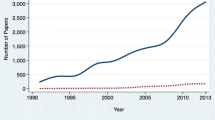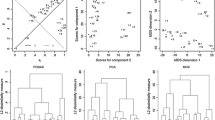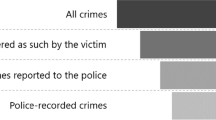Abstract
Researchers in the social indicator movement are increasingly aware of the value of obtaining both subjective and objective measures. At the same time there is a recognition of the need to understand relationships between the types of measures. Studies utilizing both subjective and objective measures indicate that while relationships between them exist, relationships are often not strong. This paper suggests several explanations for such imperfect relationships. One is scale discordance, a term used to recognize that the territorial base of an individual's subjective evaluation may not coincide with the boundaries of the unites used for the collection of objective data. Using data from a metropolitan area study, relationships between objective measures of crime and respondents' feelings of safety are examined for people whose perceptions of neighborhoods vary in size. The hypothesis that the relationship between the objective and subjective measures is stronger among individuals whose view of neighborhood size is in line with the relatively large territorial base for objective crime statistics is tested and found to be correct. Implications of the findings for research and policy making are discussed.
Similar content being viewed by others
Bibliography
AndrewsF. M., James N.Morgan, John N.Jonquist and LauraKlem: 1973, Multiple Classification Analysis (Institute for Social Research, The University of Michigan, Ann Arbor, Michigan).
AndrewsF. M. and S. B.Withey: 1976, Social Indicators of Well-Being: American's Perceptions of Life Quality (New York: Plenum Press).
AppleyardD. and M.Lintell: 1972, ‘The environmental quality of city streets: The residents' viewpoint’, American Institute of Planning Journal 38, pp. 84–101.
BradburnN. M.: 1969, The Structure of Psychological Well-Being (Chicago: Aldine).
CampbellA., P. E.Converse, and W. L.Rodgers: 1976, The Quality of American Life: Perceptions, Evaluations and Satisfactions (New York: Russell Sage Foundation).
d'IribarneP.: 1974, ‘The relationships between subjective and objective well-being’, in B.Strumpel (ed.), Subjective Elements of Well-Being (Paris: O.E.C.D.).
FlaxM. J.: 1976, A Study in Comparative Urban Indicators: Conditions in 10 Large Metropolitan Areas (Washington, D.C.: The Urban Institute).
GurinG., J.Veroff and S.Feld: 1960, Americans View Their Mental Health (New York: Basic Books).
LiuB-C.: 1975, ‘Quality of life: Concept, measurement and results,’ The American Journal of Economics and Sociology 34, pp. 1–13.
LiuB-C.: 1976, Qualitiy of Life Indicators in U.S. Metropolitan Areas: A Statistical Analysis (New York: Praeger Publishers).
MaransR. W., J. D.Wellman: 1972, The Quality of Nonmetropolitan Living: Evaluations, Behaviors and Expectations of Northern Michigan Residents (Institute for Social Research, The University of Michigan Ann Arbor, Michigan).
MaransR. W., J. D.Wellman, S. J.Newman and J.Kruse: 1976, Waterfront Living: A Report on Permanent and Seasonal Residents in Northern Michigan (Institute for Social Research, The University of Michigan, Ann Arbor, Michigan).
RodgersW. L., et al.: 1975, The Quality of Life in the Detroit Metropolitan Area: Frequency Distributions. (Institute for Social Research, The University of Michigan, Ann Arbor, Michigan).
SchneiderM.: 1975, ‘The quality of life in large american cities: Objective and subjective social indicators,’ Social Indicators Research 1, pp. 495–509.
SchumanH. and B.Gruenberg: 1972, ‘Dissatisfaction with city services: Is race an important factor?’, in H.Hahn (ed.), People and Politics in Urban Society (Beverely Hills, California: Sage Publications).
StipakB.: 1977, ‘Attitudes and belief systems concerning urban services’, The Public Opinion quarterly 41, pp. 41–55.
TajfelH.: 1968, ‘Social perception’, in D. L.Sills (ed.), International Encyclopedia of the Social Sciences, Vol. II (New York: The Macmillan Company and the Free Press), pp. 567–575.
Author information
Authors and Affiliations
Additional information
The authors wish to acknowledge Frank M. Andrews, Willard Rodgers and Brian Stipak for their helpful comments on an earlier draft of this paper. This research was sponsored by a National Institute of Mental Health Grant No. 1 R01MH29278-01, ‘Quality of Life Indicators: Analysis of Detroit Data’.
Rights and permissions
About this article
Cite this article
Lee, T., Marans, R.W. Objective and subjective indicators: Effects of scale discordance on interrelationships. Social Indicators Research 8, 47–64 (1980). https://doi.org/10.1007/BF00364601
Received:
Issue Date:
DOI: https://doi.org/10.1007/BF00364601




